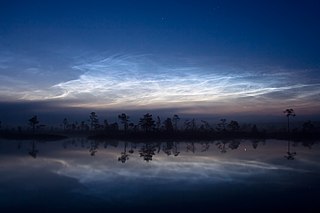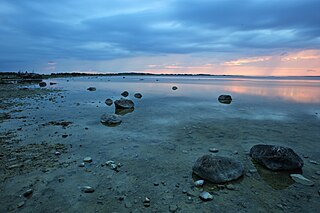
Viljandi County is one of 15 counties of Estonia. It is located in southern Estonia bordering Pärnu, Järva, Jõgeva, Tartu and Valga counties.

Hiiu County is one of 15 counties of Estonia, being the smallest county both in terms of area and population. It consists of Hiiumaa, the second largest island of Estonia, and several smaller islands near it. The county borders Lääne County to the east and Saare County to the south.

Lahemaa National Park is a park in northern Estonia, 70 kilometers east from the capital Tallinn. The Gulf of Finland is to the north of the park and the Tallinn-Narva highway (E20) is to the south. Its area covers 747 km2. It was the first area to be designated a national park of the former Soviet Union. It is the largest park in Estonia and one of Europe's biggest national parks. Its charter calls for the preservation, research and promotion of North-Estonian landscapes, ecosystems, biodiversity and national heritage.

Soomaa National Park is a national park in south-western Estonia. Soomaa protects 390 km², the park was created in 1993. Soomaa is Important Bird Area since 1989 and a Ramsar site of protected wetlands since 1997 and a Natura 2000 area since 2004.

Nigula Nature Reserve is a nature reserve situated in South-West of Estonia, in Häädemeeste and Saarde parishes of Pärnu County. It has an area of 63.98 km². Nigula nature reserve is one of the oldest bog reserves in Estonia. It is established to protect the Nigula Bog and its surrounding forests in their natural state.

The Terai–Duar savanna and grasslands is a narrow lowland ecoregion at the base of the Himalayas, about 25 km (16 mi) wide, and a continuation of the Indo-Gangetic Plain in India, Nepal and Bhutan. It is colloquially called Terai in the Ganges Basin east to Nepal, then Dooars in West Bengal, Bhutan and Assam east to the Brahmaputra River. It harbours the world's tallest grasslands, which are the most threatened and rare worldwide.

The Warta Mouth National Park is the youngest of Poland's 23 national parks. It was created on 19 June 2001 in the region of the lowest stretch of the Warta river, up to its confluence with the Odra (Oder), which marks the Polish–German border. The park covers an area of 80.38 square kilometres (31.03 sq mi) within Lubusz Voivodeship.
Matsalu National Park is a nature reserve and national park situated in Lääne and Pärnu Counties, Estonia. Matsalu National Park spans an area of 486.1 km2 (187.7 sq mi), comprising Matsalu Bay, the Kasari River delta, the village of Matsalu and surrounding areas.

Matsalu Bay is a bay in Lääne County, Estonia; the bay is part of Väinameri.
Protected areas of Estonia are regulated by the Nature Conservation Act, which was passed by the Estonian parliament on April 21, 2004 and entered into force May 10, 2004. Overall Estonia has 15403 Protected Areas covering 21.21% of the country land and 18.78% of it marine and coastal territory.

Põhja-Kõrvemaa Nature Reserve is a protected area in Harju County, Northern Estonia, some 50 km east of Tallinn. With an area of 130.9 km2, it is the third largest nature reserve in Estonia. Dominated by forests and bogs, it aims to protect rare and endangered species, their habitats, and valuable natural landscapes.

Karavasta Lagoon is the largest lagoon in Albania and one of the largest adjoining the Mediterranean Sea, spanning an area of 42 km2 (16 sq mi). Karavasta is part of the Divjakë Karavasta National Park and is separated from the Adriatic Sea by a large strip of sand. It sprawls across the Myzeqe coastal plain near Divjakë and some 20 km (12 mi) near Lushnjë.

Alam-Pedja Nature Reserve is the largest nature reserve in Estonia. It is a vast wilderness area which covers 342 km2 and consists of a complex of 5 large bogs separated by unregulated rivers, their floodplains, and extensive forests. The nature reserve aims to protect diverse ecosystems and rare species, mainly through preserving the natural development of forests and bogs and securing the continuing management of semi-natural floodplain grasslands.
Nätsi-Võlla Nature Reserve is a nature reserve situated in western Estonia, in Pärnu County, made up of several bogs that together form the largest bog area in Pärnu County.

Agusalu Nature Reserve is a nature reserve situated in eastern Estonia, in Ida-Viru County.
Sookuninga Nature Reserve is a nature reserve situated in south-western Estonia, in Pärnu County.

The wildlife of Ukraine consists of its diverse fauna, flora and funga. The reported fauna consists of 45,000 species when including the areas of the Black Sea and the Sea of Azov. Ukraine's protected environments consist of 33 Ramsar sites covering an area of 7,446.51 square kilometres (2,875.11 sq mi). Biosphere nature reserves and three national parks are all part of the GEF projects portfolio of conservation of biodiversity in the Danube Delta. Their vegetation pattern is mixed forest area, forest-steppe area, steppe area, Ukrainian Carpathian Mountains and Crimean Mountains. Some of the protected areas that were reserves or parks are subsumed under the biosphere reserves.

Oka Nature Reserve is a Russian 'zapovednik' located in the Meschera lowlands, the floodplain of the Oka River and the Pra River. With extensive lowland rivers and forested peatlands, the reserve is an important area for waterfowl and waders. The reserve hosts breeding centers for bison and for crane. The site is situated in the Spassky District, Ryazan Oblast, about 60 km northeast of the city of Ryazan. In 1994, the "Flood plains of Rivers Pra and Oka" was designated a Ramsar wetland of international importance. The site was designated a UNESCO Man and Biosphere (MAB) reserve in 1978. The reserve was formally established in 1935, and covers an area of 55,722 ha (215.14 sq mi).

Prespa National Park is a national park situated in southeastern Albania on the border triangle shared with Greece and North Macedonia. At approximately 277.5 km2 (107.1 sq mi), the park encompasses the country's sections of the Great and Small Prespa Lake. It is considerably characterised by high mountains, narrow islands, vast freshwater wetlands, salt marshes, meadows, reed beds and dense forests.















